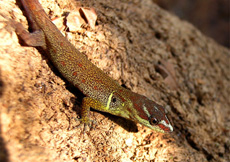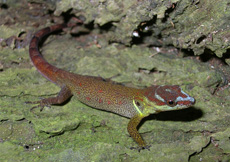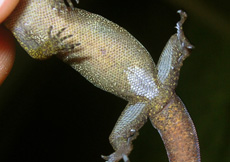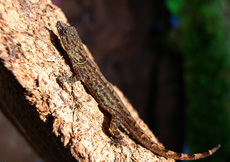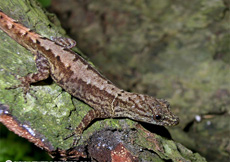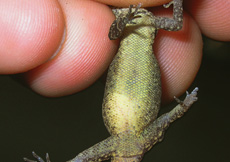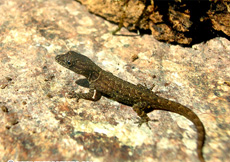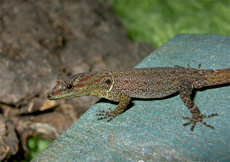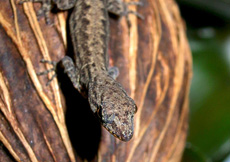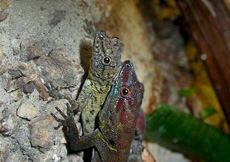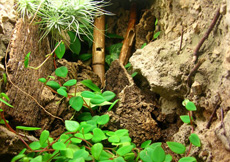Gonatodes humeralis
(GUICHENOT, 1855)
Distribution:
Gonatodes humeralis is widespread in northern South America. The distribution extends from Trinidad to the Amazon region in Brazil. To the west, the distribution of Gonatodes humeralis extends to Peru.
Description:
Gonatodes humeralis is one of the smaller members of the genus Gonatodes. Gonatodes humeralis has a total length of 8 centimeters with their tail accounting for more than half their size. Like all other members of the genus Gonatodes, the toes of Gonatodes humeralis, are covered with claws, thus they cannot climb on glass or other smooth surfaces. Their tail can be dropped easily and regenerated within a short period of time. Their pupils are round, which classifies them as diurnal and crepuscular. The males of Gonatodes humeralis have splendid colors. Their head is red, with blue bands on both sides of their nose, which come up over the eyes and form together behind the head. Their lips are lined light blue. Their neck features the characteristic golden collar of the genus Gonatodes. At the sides of the neck shortly above the golden collar, are black eye spots. Their body is reddish-brown, mixed with golden flecks and large red spots. Their tail is banded, varying from red-brown, to black as well beige. The males have a sexual characteristic between the hind legs in the form of shiny scales (Escutcheon). As with all other species of Gonatodes, sexual dimorphism is strong in this species. The base color of females is beige, with patterns in varying shades of brown. Like the males, they also have a golden collar. Over their back, a bright broad band runs across the body to the tail. Their tail is also red-brown, like the males.
In their early age, juvenile Gonatodes humeralis, resemble the female, the only difference is the back band is weaker in color.
Habitat:
Gonatodes humeralis lives on the branches of trees, up to 2 meters in altitude. During the day they sit with their head down and wait for prey. At night, the animals rise up into the treetops, to sleep on thin branches (Murphy, 1997). Thick buttress root trees are often in the interior of the forest inhabited by Gonatodes humeralis. Large populations on cocoa plantations in Trinidad have also been discovered (MURPHY, 1997). Gonatodes humeralis was also found in a single sun-exposed tree in French Guiana, under the bark of the same tree, their eggs were also discovered (Bakowskie).
Husbandry and Breeding:
Because group housing of several males or females only results in aggression, Gonatodes humeralis is best kept in pairs or individually. A terrarium with a width and depth of 30 centimeters is sufficient for a pair. In order to meet their climbing needs, one should offer the animals a terrarium measuring 40 centimeters or greater, in height. Since Gonatodes lack the ability to adhere to smooth surfaces, care must be taken when planning the decor of the rear and sidewalls. If you wanted to for example mimic their natural habitat, flat sheets of cork may be used on the rear and sidewalls. Or, if you like, you can design a fake rock. Either of these options, will provide them with the opportunity to climb properly. The substrate should be a mixture of soil and sand in a 3:1 ratio. The substrate should remain slightly moist, at all times. Natural vegetation such as, Peperomia sp. and Cryptanthus sp. or small vines like Ficus pumila var quercifolia, Episcia dianthiflora, as well Marcgravia sp. may be used. A natural planting of the terrarium helps provide a better microclimate and not only makes for a more visually appealing centerpiece, but it gives the animals more opportunities to hide. Flat pieces of cork and hollow branches placed against the terrarium walls, at varying angles, further provide additional climbing possibilities. To offer the female a place to lay her eggs, small tubes of Japanese knotweed (Reynoutria japonica) or similar should be placed at different heights against the rear and side walls. The use of such tubes allows for better control of the eggs. It is important to note however, that whatever type of tubes you select, that the insides of the tubes should not be too smooth, as Gonatodes lack adhesive discs on their toes. Once a female has selected a location for laying her eggs, it is mostly used again and again. A small water bowl and a bowl of eggshells (from older hatchlings) or cuttlefish bone (crushed - not ground) are a must in completing the setup. Despite providing my animals with a small water bowl, I find they more drink the water droplets left behind from misting. Nonetheless, a small bowl of water should still be offered for warm hot summer days, when the water droplets from misting dry pretty quickly. Daily spraying of the terrarium, helps meet the required humidity of 70%.
Illumination should be provided to the pair. A small daylight fluorescent tube combined with a basking spot (10-20w halogen puck light) helps reach the desired daily temperatures. During the summer months, the terrarium should be maintained between 26-28°C (78.8-82.4°F) daily and 22-24°C (71.6-75.2°F) during the night. Should your lighting combination raise the temperatures too much, a switch should be used to turn the heat lamp off or on as needed. Additionally, if your combination is not warm enough a small heat mat may be attached to one of the outer walls of the terrarium. The illumination period during the summer months should be for 12 hours daily. In winter the illumination period should be decreased to 8-10 hours daily. This reduction, helps cool the terrarium to daily temperatures of 24°C (75.2°F). During this period the nightly temperature should be 18°C (64.4°F). By providing a cooling period, this will allow the female a period of time to rest from the previous breeding season. Once temperatures are increased, mating will soon begin again.
Adult Gonatodes humeralis are fed twice weekly with a well varied diet, such as crickets, firebrats, aphids, woodlice, bean beetles and Drosophila. All prey are dusted with the appropriate supplements. Well fed females will lay a single egg every 16-21 days. Usually the eggs are laid within the Japanese knotweed (Reynoutria japonica) tubes. Sometimes the eggs are placed behind the gaps in the rear and side walls, or between plants. The burial of eggs in this species, has yet to be seen. Per breeding season between 8-10 eggs will be laid, however (SOIFER 1985) lists between 12-14 eggs per breeding season.
If the eggs of Gonatodes humeralis are moved to an incubator, the young will emerge following an incubation period of 3 months, if temperatures of 26°C (78.8°F) with 70% humidity are followed. The young animals are 2.8-3.2 centimeters when hatching. The offspring can be reared communally or individually with other dwarf species (not other Gonatodes species, as aggression can occur) in small household containers, which have been converted to allow for proper ventilation. The containers should be similar in setup to the terrariums of the adults. Care must be taken when selecting illumination for offspring, as juvenile Gonatodes can burn easily with the use of UVB lamps! Therefore, regular T5 or T8 tubes should be used. Offspring are fed two to three times a week with food in an appropriate size. Their diet should be well varied like the adults. Around 3 months, provided they are fed well, young male offspring will begin to change color. They should be separated from other males, or females when their sex becomes apparent. Gonatodes humeralis reaches sexual maturity at one year.
Gonatodes humeralis is a splendid representative of its genus, with the males presenting themselves with beautiful colors. Even the females have, as with females of other species, beautiful patterns. The animals are very tame and can even be fed with tweezers. If a well varied diet and proper conditions are met, keeping this species is quite simple. Unfortunately, in the European hobby there are very few people working with this species in captivity. If you do work with this species, it is of utmost importance, proper care is taken to help better establish them in captivity. Due to this last part, I can only recommend Gonatodes humeralis to experienced breeders at this time.
